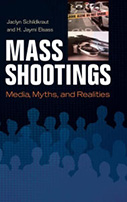Mass Shootings: Media, Myths, And Realities

Authors: Jaclyn Schildkraut and H. Jaymi Elsass
Publisher: Santa Barbara, CA: Praeger, 2016. 239p.
Reviewer: Eric Madfis | March 2017
While mass shootings garner widespread media attention when they occur, the phenomenon remains sorely understudied by scholars, especially when compared to similarly devastating instances of international terrorism or serial murder. Far too few monographs have delved deeply into the subject – and so Schildkraut and Elsass’ recent book Mass Shootings: Media, Myths, and Realities is a welcome and much needed addition to the emerging literature. Taking a holistic approach to firearm attacks at schools, workplaces, and various public locations, Schildkraut and Elsass begin the text with a helpful critique of existing definitions of mass shootings, as these vary substantially, with some definitions being unnecessarily specific while others are needlessly broad. In contrast, they forge a reconceptualization of a mass shooting as “an incident of targeted violence carried out by one or more shooters at one or more public or populated locations” with “multiple victims (both injuries and fatalities) …[that] occurs within a single 24-hour period” (Schildkraut & Elsass, 2016, p. 28). This definition is a significant improvement over many prior conceptualizations, as it avoids many unnecessary limitations due to the number of fatalities, locations, or the length of the attack. That said, it is worth noting that by limiting mass shootings to public locations, familicides are excluded, and the mass killing of one’s family in a domestic setting does constitute the most common form of a massacre in the United States (Fox & Levin, 2014). While there may be key conceptual distinctions between familicides and other types of mass shootings, and thus good cause for such specificity, the rationale for this operational criterion was not provided in the text.
As a whole, this book is an excellent introduction to the problem of mass shootings, and a worthwhile read for anyone interested in the subject. It is full of detailed information about numerous cases of mass shootings — one which provides helpful context for the varied conceptual issues discussed – such as the history and prevalence of mass shootings, research on the causal factors and prevention of these events, and the manner in which mass shootings are represented and fostered in our increasingly “mediatized” society. Each topic is covered in an academically rigorous fashion, but the myriad examples provided throughout the text dramatically increase its readability, especially for undergraduate students and the general public.
The eighth chapter entitled “Mass Shootings in a Mediatized Society” stands out as the most innovative and incisive. This chapter explores the multimedia manifestos of the perpetrators of four mass shootings (at Columbine, Virginia Tech, Jokela in Finland, and Isla Vista) in order to discern common motivations for these attacks, and to explore the ways in which these offenders desired to disseminate their thoughts and ideologies for widespread consumption in a mass media landscape. The examination in this chapter of mass shooters’ generally successful goal of creating lasting media personas via various cultural scripts is a revealing insight, and one which warrants far more future scholarship and attention from policy makers.
Far too many mistaken assumptions and myths abound regarding the causes and prevention of mass shootings. Mass Shootings: Media, Myths, and Realities dispels many of these key distortions to provide a more nuanced and research-based understanding of the reality of these horrific events.
References
Fox, J.A., & Levin, J. (2014). Extreme Killing: Understanding Serial and Mass Murder, 3rd Edition. Thousand Oaks, CA: Sage Publications, Inc.
Eric Madfis, Ph.D., is an Assistant Professor of Criminal Justice at the University of Washington Tacoma. He is the author of The Risk of School Rampage: Assessing and Preventing Threats of School Violence, published by Palgrave Macmillan in 2014.


